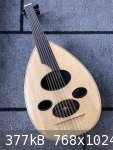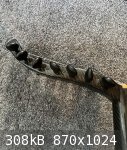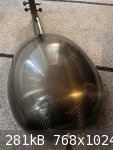
OudSwede - 8-24-2022 at 03:32 AM
Hi!
Some time ago I started to build a Carbon Fiber hybrid oud - 7 courses. The reason why I made it was mainly out of curiosity. During the time, I have
asked some questions on the forum and I am in great debt do those answering.
So, first, some info about the instrument itself, and then some reflections and pictures. Since the word of oud making often is a big secrecy, I will
here include as much info as I have experienced. I believen in the sharing of knowledge and learning from other's experiences. Just like lute building
today is organised.
Carbon Fiber Oud 2022
Shell: Carbon fiber, made by https://www.karbontasarim.de
Top: Cedar of Lebanon (Cedrus Lebani, that lived its life in Tuscany), with Macassar Ebony (so that there are no forbidden CITES woods in my
instrument) details, purfling of Swedish oak. The top is bent slightly, just like classical floating bridge ouds.
The neck is adjustable.
Scale: 60 cm.
Strings: Pyramid and Aquila.
Tuners: Wittner fine tuners
Pickup: K&K Pure Mini
Finish: Polyurethane on carbon fiber (needs UV-protective varnish), Nitro cellulose on top
Video of me playing it: https://youtu.be/Ba1PTPtubCs
Reflections
There are only little info out on the web about floating bridge oud construction. Dr Oud's book does only cover traditional
bridges. But, I found some info. The bracing is a bit different and also the bent soundboard. Thanks Sabassi for your detailed information of your
floating bridge build (http://www.mikeouds.com/messageboard/viewthread.php?tid=11244 and Ronny for all encouragement, pictures and not the least, a new friendship.
The carbon fiber shell was really interested to work with. Its so high-tech compared to wood. It can only be glued with epoxy, is super-strong
and thin. I had to glue kerfling (that was then glued with hide glue to the soundboard). The shell came with the neck in place, but hollow without
wooden parts. I was given CNC instructions for making my own wooden sections, but it was impossible in Sweden (where I live) to get someone to make
just one piece of CNC cutting. So I made them myself by hand and glued them in. Since I wanted to make the neck a bit wider to match my 7 courses, I
had to cut it off and change it a bit. That gave me the idea of an adjustable neck, just like Sukar oud and Fahdi Matta.
The construction of an adjustable neck was fun. It took some time to come up with an idea that worked. Its now fastened with two strong
stainless steel wood screws - making the flexible part - and a third stainless machine screw that can be altered from inside with an allen key. It is
fastened with a bolt in the neck. In order to make the system work, I left 0.2 mm of gap between neck and body. The system works just fine (I have
tried it). The downside with it: the neck needs adjustment after a week with strings, and it was really a pain in the neck to glue the fingerboard
onto the oud in two pieces. In the end, after one major error and wasted fingerboard, I glued a one piece fingerboard onto it, and then afterwards cut
it with a fine saw (0.2 mm wide).
The 7 courses made the whole process more difficult. It adds more pressure to the soundboard and wider neck. I adjusted the bracing with a
calculation of 1.25 times the normal height. That made the strenght to double without widening them.
Using Cedar of Lebanon was interesting to work with. It smells fantastic. It is quite stiff, especially the lines (or what they are called) in
the wood, but the sections between are very soft. It was easy to bend with heat, and easy to glue with hide glue. The sound it makes reminds of really
old ouds - a bit dry and crisp but with a deep voice. Some time ago I repaired an 70 years old oud and the soundboard had similar qualities. Spruce
has a more soft tone.
The carbon fiber bowl sounds like wood, but really hard wood. It feels a bit cold to the skin, but it feels just like an ordinary wooden oud on
the surface. I know, that traditionally, the bowl is the main part exposed of an oud, and I would say that the bowl here is not that interesting. It
looks nice, but it is more the soundboard in focus. But carbon fiber is light and super strong, so if I wanted to add an extra strenght to it it does
not affect the sound at al and is hardly visible. It can also take more heat, making the oud less prone to re-tune in changing weathers. Still, it is
sensitive to UV lightning, so I had to use a polyurethane varnish (as for cars) and car polish onto it, according to the carbon fiber maker. Sounds a
bit odd for a delicate instrument I must say. The top, on the other hand, is just like an ordinary oud. No car products there...
Making the pegbox was interesting. I made it like a traditional pegbox, but draped it in carbon fiber to match. This is the only carbon fiber
that I made myself. The carbon fiber is very strong, making the pegbox robust and thinner than usual. Since I used Wittner fine tune pegs (13 of
them), the dimensions of the pegbox had to be wider than regular.
The final reflection is about the price: Making a prototype/test is expensive. Small costs adding up. Of course, I did not have to invest in
Wittner tuners or a pickup - those were added because I myself intend to use the oud and like such things. The major cost was the carbon fiber part,
that was ordered from what I thought was a German company, but it turned out it was also a Turkish company. It was shipped from Turkey so I had to pay
customs for it. I would say, that half of the material cost was the carbon fiber shell. The soundboard and wood parts were bought from within EU,
therefore without custom charges for me in Sweden. The soundboard costed quite a lot, a bit more than similar graded spruce. But it was my intention
to mix modern materials (carbon fiber) with old traditional materials (old ouds were often made with cedar of lebanon). The intarsia was a twist from
20th century drawings of impossible objects. I guess, that if I would make such ones to sell, I would have to cut the costs on the extras. Perhaps
also start so make my own carbon fiber molds, just like Bashir ouds do.
Thank you all for making this forum such a treasure of knowledge of oud making!
Kind regards,
Viktor



coolsciguy - 8-24-2022 at 07:21 AM
Hi Victor,
It's beautiful! Hopefully this will be the first of many beautiful carbon ouds you make.
Thanks for sharing!
sylvainbd - 8-25-2022 at 12:33 AM
Hello Victor
Congrats for your project !
Make a carbon must be hard ... the first for sure !
Share here a video with a master player in your country to show all sound potential of your instrument ok ?
Last thing I read that your neck is adjustable. Did you use the Sukar maker process ?
Best regard
OudSwede - 8-26-2022 at 01:53 AM
Tanks for all kind comments!
coolsgioud: Who knows, I will definitely continue making ouds, but in this shape? Who knows...
Sylvain: I am very well aware of my limited playing skills, escpecially in front of a camera..;-) But, thanks for the tip. Regarding the adjustable
neck: I used a screw nut on the neck and drilled a hole through the upper piece of the body where the machine screw is. Its head is inside the bowl,
so If it needs adjustment, i go from inside the bowl. But I thought of making something adjustable from the outside. Perhaps on my next oud. Then the
mechanism would be reversed: a screw nut in the body, and the machine screw head in the neck, with a small hole in the neck that can be reached, just
like a rod on a guitar, but on the backside of the neck, about 10 cm from where the neck meets the bowl.
/Viktor
